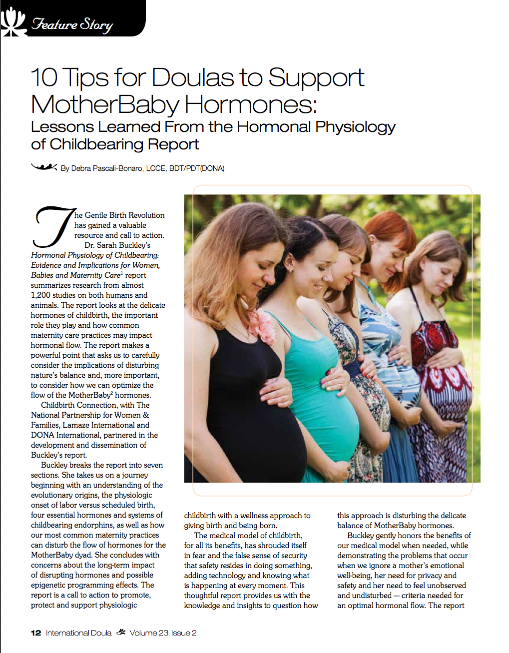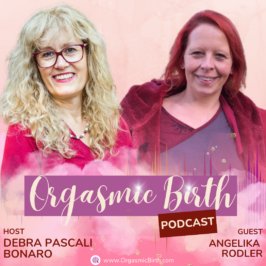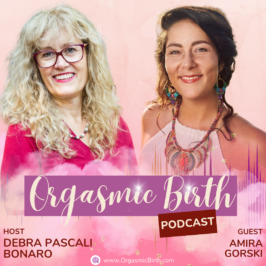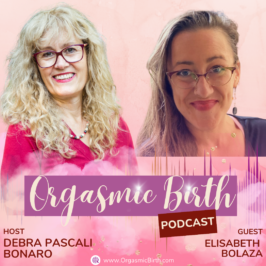This article was originally published in DONA’s International Doula Magazine Volume 23, Issue 2 (Summer 2015) Issue “10 Tips for Doulas to Support MotherBaby Hormones: Lessons Learned From the Hormonal Physiology of Childbearing Report.”
The Gentle Birth Revolution has gained a valuable resource and call to action.
Dr. Sarah Buckley’s Hormonal Physiology of Childbearing: Evidence and Implications for Women, babies and Maternity Care Report summarizes research from almost 1200 studies on both humans and animals. The report looks at the delicate hormones of childbirth, the important role they play and how common maternity care practices may impact hormonal flow. The report makes a powerful point that asks us to carefully consider the implications of disturbing nature’s balance and, more importantly, to consider how we can optimize the flow of the MotherBaby hormones. Childbirth Connection, with The National Partnership for Women & Families, Lamaze International and DONA International, partnered in the development and dissemination of Dr. Buckley’s report.
Dr. Buckley breaks the report into seven sections. She takes us on a journey beginning with an understanding of the evolutionary origins, the physiologic onset of labor versus scheduled birth, four essential hormones, systems of childbearing endorphins, as well as how our most common maternity practices can disturb the flow of hormones for the MotherBaby dyad. She concludes with concerns about the long-term impact of disrupting hormones and possible epigenetic programming effects. The report is a call to action to promote, protect and support physiologic childbirth with a wellness approach to giving birth and being born.
breaks the report into seven sections. She takes us on a journey beginning with an understanding of the evolutionary origins, the physiologic onset of labor versus scheduled birth, four essential hormones, systems of childbearing endorphins, as well as how our most common maternity practices can disturb the flow of hormones for the MotherBaby dyad. She concludes with concerns about the long-term impact of disrupting hormones and possible epigenetic programming effects. The report is a call to action to promote, protect and support physiologic childbirth with a wellness approach to giving birth and being born.
The medical model of childbirth, for all its benefits, has shrouded itself in fear and the false sense of security that safety resides in doing something, adding technology and knowing what is happening at every moment. This thoughtful report provides us with the knowledge and insights to question how this approach is disturbing the delicate balance of MotherBaby hormones. Dr. Buckley gently honors the benefits of our medical model when needed, while demonstrating the problems that occur when we ignore a mother’s emotional well-being, her need for privacy and safety and her need to feel unobserved and undisturbed—criteria needed for an optimal hormonal flow. The report calls into question the short and long-term consequences for each MotherBaby dyad, and family, when we disturb nature’s delicate hormonal orchestration. Sarah Buckley offers this advice: “Hormonal physiology understandings give a powerful endorsement of the work that doulas do to support physiologic birth. I recommend that doulas use the scientific evidence in this report to support their rightful role in the childbearing team.” So where do doulas begin to claim our rightful role?
Here are the 10 areas in which a doula can and must make difference:
Read the report to better understand how the four key hormones of childbirth prepare MotherBaby for birth and breastfeeding. Understand how common maternity practices can impede the release of these key hormones.
Oxytocin – Causes labor contractions (surges or waves), reduces stress, promotes healing and feelings of love, calmness and connection to others.
Beta-endorphins – Help relieve stress and pain around the time of birth and create feelings of pleasure and reward.
Catecholamines -Create MotherBaby alertness and readiness for birth, help protect baby’s heart and brain during strong labor contractions and prepare for the huge newborn transition
Prolactin -A major hormone of reproduction, reduces stress, and is called the “mothering hormone.” Its many roles include making milk, as well as helping the mother adapt to her mothering role (maternal adaptations).
2. Ensure that Mothers, Fathers, Partners and Families have access to this information.
The National Partnership for Women & Families and Childbirth Connection created a wonderful booklet for parents: “Pathway to a Healthy Birth: How to Help Your Hormones Do Their Wonderful Work.”There is also a simple Healthy Birth Pathway infographic with some of this information.
In addition, Lamaze International synthesizes the Hormonal Physiology of Childbearing report in the Lamaze Hormones and Healthy Birth series. Lamaze provides accessible resources for parents to understand the delicate balance of hormones, along with their role in creating optimal birth, bonding and breastfeeding. They also offer resources on common interventions that can disturb the delicate balance of hormones and the effects each disturbance can have on giving birth with ease and pleasure.
3. Facilitate an environment that supports the release of the MotherBaby hormones.
1. I call this creating birth ambiance. Birth ambiance includes the elements in the environment that help women feel safe, private and undisturbed, which are key aspects of ensuring birth hormones flow with ease. This can help reduce catecholamines (epinephrine-norepinephrine). Elevations of these hormones in early labor, which can occur when a woman (or any animal) does not feel safe, can slow or stop labor. Doulas are the keepers of the birth ambiance, which includes consideration of:
Vision – What type of lighting, bright or dim, helps her feel calm and safe?
Sounds – What sounds and music create a peaceful and loving feeling?
Smells – What smells bring her deeper into her ability to feel safe and surrender to the process?
Touch – Does she like touch, where or not? and how?
Mind – What helps calm her mind? Visualizations, mantra, prayer and meditation are helpful for her intuitive primal brain to create and release MotherBaby hormones.
Privacy and Safety – How can we facilitate what each mother needs to feel private and safe?
4. Promote feelings of calm and relaxation
Encouragement and support during pregnancy and throughout labor enables women, their partners and others to stay calm and relaxed, rather than becoming stressed and anxious. This also allows for the optimum flow of hormones that promote labor progress, minimizing the stress hormones that can slow or stall labor. As Dr. Buckley says:
“Aspects of contemporary pregnancy care may have unintended negative (nocebo) effects by increasing maternal stress and anxiety. Stress and anxiety in pregnancy can elevate maternal stress hormones, including epinephrine-norepinephrine and cortisol, with detrimental long-term effects on offspring, including impacts on brain development and stress responsiveness, as established in human and animal studies. Studies suggest that maternal relaxation techniques may reduce pregnancy stress and its detrimental effects…Stress may slow labor by reducing pulsatile oxytocin and/or by increasing beta endorphins.”
Doulas can play a vital role in teaching and sharing relaxation techniques prenatally, at our home visit(s), as well as facilitating the relaxation response in labor.

5. Minimize disruptions in the oxytocin system
Encourage ways women can release their own oxytocin, including movement, kissing, touching, connection, eye contact with loved ones, nipple stimulation and other ways she is comfortable connecting with her sensuality and sexuality. It’s also important to bring awareness to stressful elements that will inhibit oxytocin’s release, such as being observed.
6. Modulate and enhance comfort and pleasure
Doulas can use techniques to help women find comfort, including movement, staying active and upright, the use of birth balls, breath awareness, Penny Simkin’s three Rs (relaxation, rhythm and ritual, and I would add a fourth, the rebozo), facilitating access to water, hot and cold compresses, acupressure, touch and comfort techniques (such as the double hip squeeze). Doulas are often the gatekeepers to comfort at birth, and I always include simple ways to find pleasure, such as dancing, singing, or whatever they find pleasurable!
7. Emotional w ell-being: minimize stress, reduce and acknowledge women’s fears and help her to connect with and release her emotions
ell-being: minimize stress, reduce and acknowledge women’s fears and help her to connect with and release her emotions
Doulas help by creating a MotherBaby cocoon of safety. This can reduce the cascade of interventions by keeping the hormones flowing. Penny Simkin has taught us to create a safe, private time to check in with the laboring woman for the opportunity to assist in releasing emotions that may be holding her back. Dr. Buckley says: “Attention to the emotional well-being may promote labor progress. The reduced need for labor interventions associated with doula and midwifery care may reflect this beneficial focus.”
8. Bring more respect, dignity and love to all
Far too many women are suffering the consequences of our fast-paced, technology driven, and sometimes even abusive, maternity care system. The system does not always respect laboring women or listen to their voices. As doulas, our role is to bring respect to all involved, women, partners, caregivers, and others. Doulas provide and create an environment for every woman to be cared for with dignity. Doulas facilitate each woman’s voice being heard as part of collaborative decision making. Our belief and trust in women and birth goes a long way toward encouraging women and their partners to relax and run their own hormones of love.
Our emotions are contagious. H ave you ever felt how one person can enter a room and change the energy from peace and calm to chaos and fear? It is also true with love. Holding the space for love and bringing our unconditional love goes a long way in helping MotherBaby, partner and family to stay in their love and give birth with love.
ave you ever felt how one person can enter a room and change the energy from peace and calm to chaos and fear? It is also true with love. Holding the space for love and bringing our unconditional love goes a long way in helping MotherBaby, partner and family to stay in their love and give birth with love.
I have had the pleasure to learn so much from Midwife Robin Lim and Midwife Katherine Bramhall at a training in Bali (Sarah Buckley even joined us one year!) They have helped me to understand that birthing in love provides safety for the woman and ease in birth. Love heals! A doula’s role is to create the loving feelings, to love the woman through labor. As Ina May Gaskin tells us, “The energy that gets the baby in, gets the baby out!”
9. Promote continuous support/doulas.
Provide a “Meet the Doula” night in your community to educate expectant parents about doulas. This event is also an opportunity to support and encourage more women to become doulas. We doulas have an obligation to promote our profession, because we play a key role in keeping birth safe. Even ACOG recently acknowledged in their report “Safe Prevention of the Primary Cesarean Delivery,” in which they state that doulas are underused “Published data indicate that one of the most effective tools to improve labor and delivery outcomes is the continuous presence of support personnel, such as a doula.”
10. Become a birth activist!
Doulas are on the front line, bearing witness to birth – both the benefits, and sadly the drawbacks. Our overmedicalized childbirth model seems to value physical health, but often overlooks the emotional well-being of MotherBaby as an important outcome of childbirth. It’s not enough to survive childbirth, women must thrive as well! While at a birth, the doula’s role is to protect and nurture a woman’s memory of birth. This may include helping to amplify the voice of the mother and her partner, supporting them to share their birth desires and facilitating positive collaborative decision making with respect and dignity for all.
Doulas have a unique view into the landscape of maternity care that no other provider has. I see birth at home, in birth centers and at hospitals – observing the wide variation in practices that each provider defines as safe. As I leave a birth, I take off my doula hat and weave and grow my activist hat, where I have an opportunity to share what I have learned from these varied perspectives, to speak up on my own behalf.
Now in combination with the Hormonal Physiology of Childbearing report, we can promote policies and practices that support physiological childbirth, while enhancing the MotherBaby’s natural release of the hormones of childbirth while protecting MotherBaby bonding and breastfeeding. This report provides a solid foundation to speak up and out about the need to help women and their partners have access to evidenced based maternity care that considers the impact of the hormonal physiology of childbirth.
 Doulas are at the forefront! Please read, heed and pass along the wealth of information contained in this ground breaking report. You can start with the consumer booklet, infographic and clinician factsheets. For an overview, read the executive summary and topline recommendations and dip into the full report in your areas of interest which is clearly organized and also searchable.
Doulas are at the forefront! Please read, heed and pass along the wealth of information contained in this ground breaking report. You can start with the consumer booklet, infographic and clinician factsheets. For an overview, read the executive summary and topline recommendations and dip into the full report in your areas of interest which is clearly organized and also searchable.
Dr. Buckley leaves us to consider both the short and long-term effects on each MotherBaby when these essential hormones are disturbed and not flowing as nature intended during birth. We must also ponder not only the individual effects, but also the effects that each birth and each child has on family, community and society.
Combining this new information with the doula’s innate knowledge of female wisdom and traditions, we become keepers of the circle of support of childbirth. We create the ambiance, privacy and safety that is needed and often missing from today’s birth environments. Doulas must protect and promote the flow of these essential MotherBaby hormones of love, pleasure, alertness, readiness and mothering. A doula’s respectful, loving presence at the sacred gateway of childbirth is an essential link in our maternity care system. This love can increase a mother’s ability to give birth in the hormonal flow nature intended, bringing the joy, bliss, love, bonding and connection that is the birthright of every MotherBaby.
Pain to Power online childbirth education and online childbirth videos supports this report and encourage release of MotherBaby Hormones. Learn more today about Pain to Power Childbirth.
Additional Resources:
Hormones & Healthy Birth: Bring a Loved One, Friend, or Doula for Continuous Support, Feb 11, 2015 Terreri, Cara
Pathway to a Healthy Birth: How to Help Your Hormones Do Their Wonderful Work
Hodnett ED, Gates S, Hofmeyr G J, Sakala C, Weston J. Continuous support for women during childbirth [PDF]. Cochrane Database Syst Rev 2012, Issue 10
American College of Obstetricians and Gynecologists and Society of Maternal-Fetal Medicine, 2014. Safe Prevention of the Primary Cesarean Delivery. Obstetric Care Consensus Number 1. Obstet Gynecol ;123:693–711.
Buckley S., Gentle Birth, Gentle Mothering: A Doctor’s Guide to Natural Childbirth and Gentle Early Parenting Choices. Celestial Arts, Berkeley 2009
Buckley S. Ecstatic Birth. Nature’s Hormonal Blueprint for Labor. 2010. www.sarahbuckley.com
Simkin, The Birth Partner – Revised 4th Edition: A Complete Guide to Childbirth for Dads, Doulas, and All Other Labor,2013










2 Responses